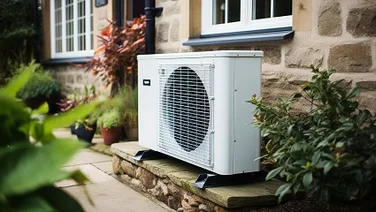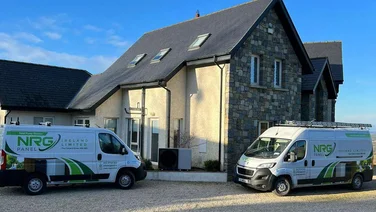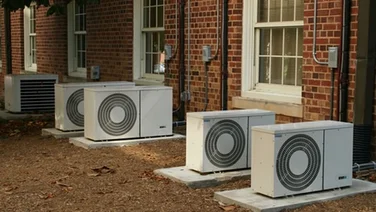- A heat pump is a fossil fuel-free home heating system
- The most common types in the UK are air source and ground source heat pumps
- Heat pumps cost anywhere from £1,600 to £35,000, depending on the type
Heat pumps are set to become a common feature of homes—and why not, when they can pluck heat from the air, ground, or water and turn it into a clean, unlimited source of energy? With the government helping with the upfront cost of heat pumps, it’s never been easier to invest.
If you want to join the thousands of UK homeowners currently using heat pumps, you’re in luck. It’s never been easier to compare prices with our easy-to-navigate tool.
All you have to do is provide a few quick details, and our expert installers will be in touch with free quotes for you to compare.
What type of central heating do you currently use?
Get started
What is a heat pump?
In short, a heat pump is a machine that moves (pumps) heat from one source (air, ground, or water) to another, like the air inside your home or water systems like your central heating or hot water systems.
It archives this using a special liquid called a refrigerant (yes, just like your fridge) that either heats or cools a space by compressing or expanding the liquid.
These systems are typically reversible, meaning the process can be reversed to “pump” the heat from your home to the outside. This is the case with so-called air conditioners (these are just a type of heat pump), which can mechanically cool your home during the summer months.
Image of a typical domestic air-source heat pump compressor (AKA an outdoor unit). This does most of the donkey work, with indoor units doing the business end of heating or cooling. The technology is pretty old and well-established, but few, if any, people in the UK currently use it for heating. But you probably already have one form you use daily: your fridge. A heat pump (when in heating mode) is basically the same technology but used in reverse.
They are very common on the continent and in the US. Heat pumps are powered by electricity and have very high efficiencies in terms of turning fuel (electricity) into heating or cooling, typically in the 100s of percent. For this reason, they are seen as a great way to help cut down energy bills.
How does a heat pump work?
- In heating mode, a heat pump extracts heat from the outside air, ground, or water and transfers it indoors.
- It absorbs this heat using a liquid refrigerant in sealed pipes, which becomes a gas.
- This gaseous refrigerant is then compressed, increasing its temperature (similar to what happens at the back of a fridge).
- The hot gas then passes through a heat exchanger, transferring heat to the home’s heating system and hot water supply.
- After the heat is released, the gas cools, condenses into a liquid, and repeats the cycle (much like how a fridge cools your food).
- The heat extraction method depends on the type of heat pump (air source, ground source, or water source).

Different types of heat pumps extract heat from different outside sources (air, the ground, water), but once they have it, they more or less function the same way.
All heat pumps, except air-to-air heat pumps, are designed to work as part of a ‘wet heat system.’ This means they heat water (indirectly), which flows to radiators throughout the house.
Air-to-air heat pumps operate as part of a ‘dry heat system,’ which means they heat air sent to rooms in the house through vents or ducts.
Crucially, all heat pumps are powered by electricity. They don’t use electricity to generate heat, as an electric radiator does, but they use it to power the systems that extract and transfer heat.
What type of central heating do you currently use?
Get startedTypes of heat pumps
The four types of heat pumps are:
- Air source heat pumps
- Ground source heat pumps
- Air-to-air heat pumps
- Water source heat pumps
Air-source heat pumps (or air-to-air heat pumps) draw heat from the outside air and use it to heat your home. They can do this at temperatures as low as -25°C, although they typically work harder when temperatures go below freezing.
This means you’ll need a separate system to heat water for bathrooms, such as a heat pump water heater. Air-to-air heat pumps can also be used for air conditioning in the summer since they can switch from hot air to cool air.

Ground-source heat pumps draw heat from the ground through a loop or borehole system buried in the land surrounding the home. When it’s 0°C outside, the ground temperature usually stays at a comfortable 10°C, which makes ground-source heat pumps more efficient in winter than air-source heat pumps.
You’ll need a fair amount of space (such as a large garden) to install these systems.
Water source heat pumps draw heat from a nearby water source, such as a pond, lake, or river. They’re the most efficient type of heat pump because water transfers heat effectively and usually stays warmer than the air and the ground in winter.

For specifics on the different types of heat pumps, visit our full guide.
How are air-, ground-, and water-source heat pumps different?
The basic process of using a refrigerant to pump heat from one area to another is the same for all types, but they differ dramatically in how they do this.
- Air-Source Heat Pumps: Extract heat from the outside air, even in cold weather. They are the most common and easy to install but can be less efficient in extremely cold climates.
- Ground-Source (Geothermal) Heat Pumps: Use heat from the ground, where temperatures remain more consistent year-round. They are more efficient than air-source but require more space and higher installation costs.
- Water-Source Heat Pumps: Extract heat from a nearby water source, like a lake, river, or well. They are efficient but depend on having a suitable water source nearby.
Another difference is the efficiency of the systems, installation process, and cost, with ground-, and water-source pumps typically much more expensive than air-source ones.
However, all heat pumps are more efficient than gas boilers, reaching up to 400% efficiency. As Linda, owner of an Octopus Energy Cosy heat pump, said: “We’ve only recently installed the heat pump and we’re already seeing savings.”
| Type of Heat Pump | Installation Complexity | Average Costs | Efficiency |
| Air-Source | Relatively easy; can be installed on exterior walls or rooftops | £1,600 – £15,000 (depending on size and climate) | Moderate to high; less efficient in very cold weather |
| Ground-Source | Complex; requires underground piping, more space, and excavation | £16,200 – £49,000 (higher upfront cost due to excavation) | Very high, stable ground temperatures improve efficiency |
| Water-Source | Moderate; requires access to a water source like a lake, well, or river | £6,000 – £11,000 (depends on water source proximity and system size) | High; efficient but dependent on the temperature and availability of water source |

How are heat pumps installed?
The first step is to hire a qualified installer, as this is a job that’s worth leaving to a specialist. They will assess your property and determine the right size heat pump for your home.
When installing an air source heat pump or an air-to-air heat pump, the installer will find an appropriate place outside the property for the outside unit, with all the space it needs to access a good flow of air constantly.
Installing ground source heat pumps is a little more complicated. The installers will have to excavate an area of ground in your property to lay the pipework that will absorb heat. These can be vertical boreholes or a horizontal loop system.
A little excavation is also required for water source heat pumps. Loops of pipes collecting heat will have to be placed in the nearby water source, and these will be connected to your house through pipes buried in the ground.
All heat pumps must also have some form of pipework installed through your outside walls. The necessary pipes and cables will then connect them to a separate indoor unit or, in some cases, the heating network inside your home.
Your installer will then install at least one control panel or thermostat inside your home so you can check and alter the way your pump is running.
In the case of air-source heat pumps and air-to-air heat pumps, the entire process should take between one and two days, depending on the size of your home.
The process might take up to a week for ground or water source heat pumps.
What are the pros and cons of heat pumps?
- Lower installation cost than ground or water source
- Works well in mild climates
- Relatively easy to install
- Can provide both heating and cooling
- Requires less space than ground source systems
- Less efficient in very cold weather
- May require backup heating
- Shorter lifespan compared to ground source systems
- Performance depends on outdoor temperature fluctuations
- Not suitable for all properties
- Highly efficient, stable ground temperatures improve performance
- Long lifespan with proper maintenance
- Can provide both heating and cooling
- Works well even in extreme cold
- Can significantly reduce energy bills over time
- High upfront installation cost
- Requires significant land or space for installation
- Complex installation process with excavation
- May take several years to recoup costs
- Not suitable for all properties
- Highly efficient, especially if the water source is consistent
- Stable performance year-round
- Suitable for large buildings or facilities
- Can provide both heating and cooling
- Lower environmental impact if a water source is abundant
- Requires proximity to a water source like a lake or well
- Installation can be complex and costly
- Dependent on water quality and availability
- Potential for environmental impact if not managed properly
- Limited to areas with appropriate water sources
How much does a heat pump cost?
Heat pumps cost between £1,600 and £35,000, depending on their size and the type of heat pump.
Air-source heat pumps cost £10,000 for the average three-bedroom house and up to £15,000 for a five-bedroom house. Water-source heat pumps are in a similar price range.
Ground-source heat pumps are more expensive than air-source ones, costing between £17,000 and £35,000.
| Property size | Air source heat pump size | Air source heat pump cost | Ground source heat pump size | Ground source heat pump cost |
|---|---|---|---|---|
| Two-bedroom | Three-bedroom | Four-bedroom | Five-bedroom | |
| 5 kW | 10 kW | 13 kW | 16 kW | |
| £7,000 | £10,000 | £13,000 | £15,000 | |
| 4 kW | 8 kW | 11 kW | 13 kW | |
| £17,000 | £24,000 | £30,000 | £35,000 |
These costs are representative and don’t reflect exactly what you’ll pay. Heat pump installations are always priced on a case-by-case basis. Our ground source heat pump pricing is based on a horizontal installation with trenchesHeat pump running costs
Running costs for a ground-source heat pump for a three-bedroom household will typically be around £939 per year.
The average air source heat pump will cost about the same, though this can vary significantly, depending on where you live in the UK.
| Heating method | Efficiency (%) | Annual energy use (kWh) | Cost (p/kWh) | Annual bill |
| Gas boiler | 95 | 11,500 | 7 | £805 |
| Heat pump | 300 | 3,833 | 24.50 | £939 |
| Oil boiler | 92 | 11,875 | 7.65 | £909 |
| Electric boiler | 100 | 10,925 | 24.50 | £2,676 |
Are there grants for heat pumps?
Yes, there are several grants for heat pumps.
The government’s Boiler Upgrade Scheme is the main grant for heat pumps. It will reduce the cost of air-, ground-, or water-source heat pumps by £7,500.
This means an air-source heat pump will cost the average homeowner £2,500 instead of £10,000, which is cheaper than a gas boiler.
There are other heat pump grants for low-income families, including the nationwide ECO4 Scheme, Nest in Wales, and Warmer Homes Scotland in Scotland.
How efficient are heat pumps?
Believe it or not, heat pumps (irrespective of type) will tend to have advertised efficiencies over 250%, usually much higher. “But,” we hear you cry, “how can that be possible?” Isn’t 100% the maximum you could ever get?
That would be true if we directly converted fuel (electricity) to heat or cooling. However, heat pumps don’t work like that. Rather, they use electricity to beg, steal, and borrow heat from one place and move it to another. So long as there’s available heat to extract from the environment, the pump can transfer more energy than it consumes, leading to these seemingly “over 100%” efficiencies.
For this reason, when talking about heat pumps, you’ll hear terms like the Coefficient of Performance (COP) rather than efficiency. COPs are usually recorded as single digits or fractions like 3 (300%) or 3.5 (350%). You may also see a term called the seasonal performance factor, SPF for short.
This gives you an idea of the heat pump’s overall efficiency over an entire heating season. So, think of the COP as a snapshot and SPF as an average COP over time.
These numbers mean that for every unit of electrical energy a heat pump consumes, it will deliver or move 3 units of heat energy. In reality, this is just an average, as heat pumps, especially air-source heat pumps, have varying operational efficiencies yearly.
They are, for example, most effective in the summer months and tend to struggle in winter. Ground- and water-source heat pumps are generally better overall as the temperature of the ground/water is more stable throughout the year.
For units that also provide cooling, another metric, the energy-efficiency rating (EER) or seasonal energy–efficiency rating (SEER), is also usually provided. These values effectively tell you how “efficient” they are regarding cooling output per energy consumed. The former, like the COP, is more of a snapshot of the system’s efficiency at any time, while the latter provides a guide over an entire cooling season (and is, therefore, a bit more useful).
How many homes in the UK have heat pumps?
According to the MCS Foundation (the UK’s primary overseer for things like heat pumps), around 220,000 heat pumps have been installed in the UK so far, and this number is set to grow.
“There was a 25% increase in MCS-certified air-source heat pump installations last year,” the MCS Foundation reports.
The government has set a goal to install 600,000 heat pumps per year by 2028, and is planning to phase out gas boilers by 80% by 2035. This means millions of people across the UK will need another way of heating their homes.
However, as it stands, only half of people are aware of heat pumps, even if these machines are becoming increasingly popular – and for good reason.
As we move towards a time when the UK is responsible for net-zero carbon emissions, you can future-proof your home by getting a potentially 100% renewable source of electricity – all while cutting your energy bills.
And it’s not just in the UK. The number of households buying air-source heat pumps in North America, Europe, and northern Asia is set to triple by 2025, according to the International Energy Agency.
By 2030, 22% of homes in these regions will have air-source heat pumps.
Next steps
You’re ready. You have all the knowledge you need right at your fingertips, and you’re fully prepared to save money and CO2 by purchasing a new heat pump.
Find the model you want, hire an MCS-certified installer to install it, and before you know it, you’ll be making your wallet and the Earth a better place.
To speed up the process, try using our custom-built tool. All you have to do is provide a few quick details, and we’ll put you in touch with our heat pump suppliers, who will send you free quotes.
FAQs
Do heat pumps work with radiators?
Air, ground, and water source heat pumps all work with radiators. They’re designed to be integrated into the home’s existing heating system.
However, heat pumps typically require radiators that are 2.5 times larger than standard.
Why? Well, heat pumps produce heat at a lower temperature, and release it more slowly than a boiler. So, for a room to achieve the same level of warmth as it would with a boiler, the heat releasing surface (in this case the radiator) needs to be larger.
What homes are not suitable for a heat pump?
Poorly insulated homes are generally not suitable for a heat pump. Heat pumps produce heat at lower temperatures than boilers, so if a home is poorly insulated, the heat pump might not be able to keep it at a comfortable temperature for the inhabitants.
That being said, all homes can be made suitable for heat pumps through insulating measures, such as double glazing, and floor or wall insulation.
Read more about if UK housing is suitable for heat pumps or not on our page.
How noisy is a heat pump?
Heat pumps are not very noisy. They produce a low hum, around 40 decibels. This can go up to 60 decibels when the heat pump is working hard.
For reference, that’s around the same level of noise a fridge produces.







